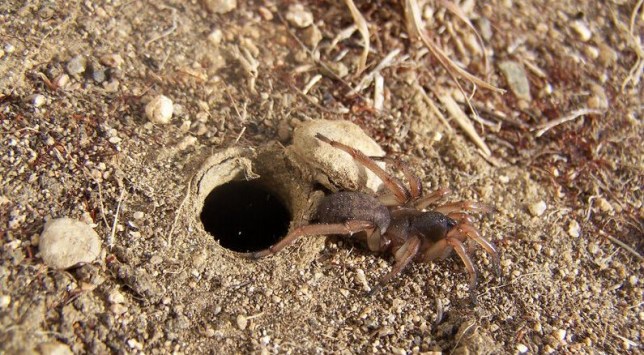Oh how we laughed when Ron Weasley was haunted by nightmares of tap dancing spiders in Harry Potter. Well you might not be laughing now – because they’re real, and they’re back from the dead.
However, it’s actually a cause for celebration.
Fagilde’s trapdoor spider, a native of Portugal, has been missing and possibly extinct for more than 90 years, but thanks to a dedicated team from the Re:Wild charity, these elusive arachnids have been found alive and kicking.
Well, alive and killing – by building burrows hidden beneath camouflaged trap doors that they unlock when unsuspecting prey walks over them, plunging into the darkness below.
If that’s not scary enough, when young spiders emerge from these burrows they set up their own nearby, creating ‘spider towns’.
And the tap dancing?
Well, that’s part of the male’s mating ritual to help create more of these crafty critters, tapping on the door of the female’s burrow and ‘singing’ to her through the medium of dance.
Trapdoor spiders are found across the world, in Europe, the US, South Africa and Australia.
However, this particularly talented species has proven elusive since the first fleeting glimpse of it in 1931. It was discovered by pioneering entomologist Amelia Bacelar, who was only able to collect two female specimens.
They were housed in a Portuguese museum, which burnt down in 1978, destroying the only known evidence of their existence.
Until now.
Led by Sérgio Henriques, a team from Re:Wild has spent years combing the undergrowth around the village of Fagilde in north-central Portugal, where the spider was first discovered.
‘It takes a lot of time to look for signs of this species,’ said Mr Henriques, who is the invertebrate conservation coordinator at the Global Center for Species Survival at the Indianapolis Zoo and co-chair of the IUCN SSC Spider and Scorpion Specialist Group.
‘Some lost species that are bigger and don’t live underground might be easier to stumble across, but this is not one of them. This is too cryptic, it hides too well. You have to be very intentionally looking for it in a specialised kind of way.’
The spiders’ burrows are only about an inch wide, and with the secure trapdoor and leaf litter covering them, finding them is no mean feat.
‘It’s impossible to explain, but even when you remove the moss and leaf litter from the top of a trapdoor, you see nothing,’ said Mr Henriques. ‘There is nothing to be seen. The lid is exactly the same materials and the exact same color as the ground.
‘It’s just me on the ground on my knees, looking at the floor with all the patience in the world, just looking at it very hard and trying to see something circular in the ground. That’s all we can do. Just look at it. We look for patterns.
‘For each trapdoor I find, I find a thousand fake trapdoors.’
But after much searching, another member of the team, Luis Crespo, knocked at a promising trapdoor – one that was locked, meaning a spider was home.
Mr Henriques dug a hole in through the side of the burrow, and found a mama spider with ten baby spiders. He carefully removed part of one of her legs – they grow back, like lizards’ tails – and sealed the burrow back up.
However, the next challenge was just as tricky. With no existing specimens of Fagilde’s trapdoor spider, how could the team prove they had found one?
The only option left was by process of elimination. Sequencing the genome from the sample, they then compared it to other known trapdoor spiders in the region.
‘Nothing else resembles this species, and no evidence suggests that there’s more than one species of trapdoor in the area,’ said Mr Henriques. ‘This would be, to the best of our knowledge – to the best of anyone’s knowledge – a rediscovery.’
But the team aren’t resting on their laurels, or burrows. They’re continuing to collect more information, and working with locals to help them spot more spiders.
‘If it still exists in a particular habitat, that means that whatever is happening there, it’s what we should be doing more of,’ said Mr Henriques.
‘If we find the species in certain places and understand how that place has sustained it, we can take that information to the local government and local stakeholders to work together to protect it so that we don’t lose it again.’
And to make sure it doesn’t just exist in people’s nightmares.
MORE : Bizarre creature named after David Attenborough found after 60 years
MORE : Jessie the detection dog tracks down golden mole missing for 80 years
MORE : Scientists just made a huge leap forward in bringing animals back from the dead
Follow Metro across our social channels, on Facebook, Twitter and Instagram
Share your views in the comments below
Get your need-to-know
latest news, feel-good stories, analysis and more
This site is protected by reCAPTCHA and the Google Privacy Policy and Terms of Service apply.













